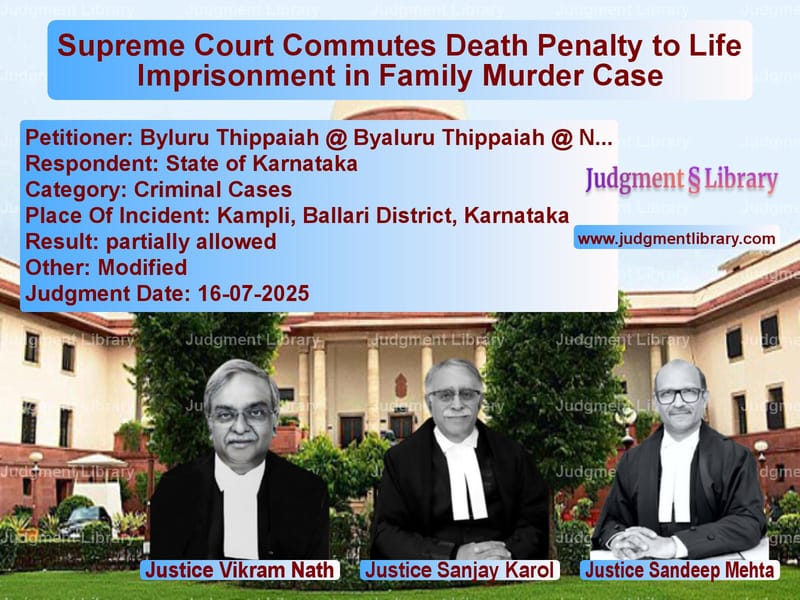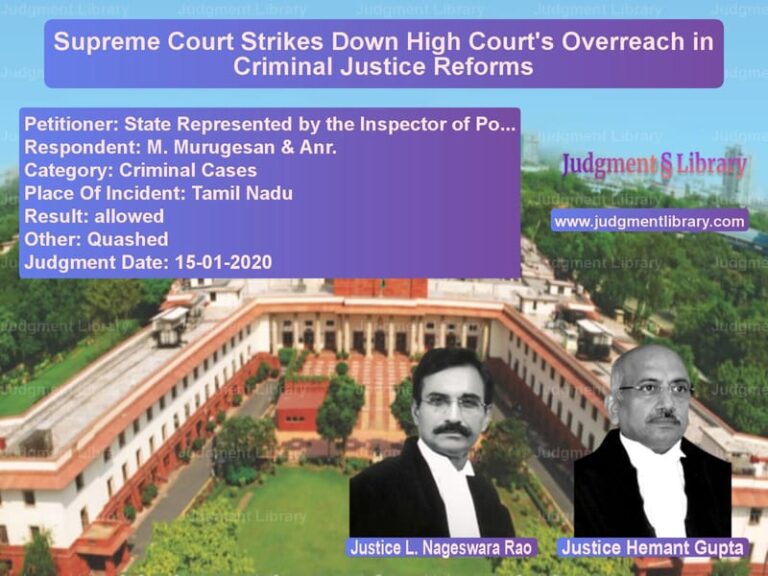Supreme Court Commutes Death Penalty to Life Imprisonment in Child Rape-Murder Case
In a deeply troubling case that shook the conscience of the nation, the Supreme Court of India recently delivered a significant judgment balancing the brutality of a crime against the principles of sentencing in capital punishment cases. The case involved the horrific sexual assault and murder of a 10-year-old girl, whose innocent desire for candy or a toy was exploited in the worst manner possible by the appellant. The case reached the Supreme Court as a final appeal against the death penalty confirmed by the High Court of Uttarakhand.
The tragic events unfolded on July 28, 2018, when a 10-year-old girl, identified only as ‘X’ to protect her identity, was playing outside her house with cousins and friends. What began as a normal afternoon of childhood play ended in unimaginable tragedy when the appellant, Jai Prakash, lured the children to his hut with the promise of money for sweets. He gave Rs. 10 to each child but selectively kept X behind in his dwelling while letting the others go. This calculated act marked the beginning of a sequence of events that would end with the brutal rape and murder of an innocent child.
The Prosecution Case
The prosecution built a strong case against Jai Prakash based on multiple strands of evidence. The father of the victim, Sant Pratap, immediately began searching for his daughter when she went missing around 12:30 PM. Upon questioning the other children who had been playing with X, he learned that the appellant had taken all the children to his hut and given them money. When Sant Pratap confronted Jai Prakash about his daughter’s whereabouts, the appellant claimed that X had taken the Rs. 10 note and left. This would later prove to be a deliberate lie meant to misdirect the search efforts.
The search continued for hours until Mohd. Alam, sent by the site contractor Kulbhushan, discovered the horrifying truth. The body of X was found concealed underneath empty cement bags in the corner of Jai Prakash’s hut. The post-mortem examination conducted by Dr. Chirag Bahugana revealed the cause of death as ‘manual throttling by hand causes asphyxia.’ The medical evidence clearly indicated sexual assault, with all injuries occurring prior to death. The examination established that the child had been brutally raped and then strangled to death by hand.
The Trial and High Court Proceedings
The Fast Track Court, Special Judge (POCSO)/Additional District and Sessions Judge, Dehradun, after careful consideration of the evidence, convicted Jai Prakash under Sections 376, 377, 302 of the Indian Penal Code and Section 5/6 of the Protection of Children from Sexual Offences Act, 2012. The court imposed the death penalty, characterizing the case as the ‘rarest of rare.’ The judgment highlighted several key pieces of evidence: the last seen theory established through child witnesses, recovery of the body from the appellant’s hut, and most crucially, DNA evidence linking Jai Prakash to the crime.
The High Court of Uttarakhand at Nainital, in its impugned judgment dated January 7, 2020, confirmed both the conviction and death sentence. The High Court noted that the appellant himself admitted to being in his room on the date of the offense, and since the body was found in his room, this pointed strongly to his guilt. The DNA evidence presented a compelling case – the DNA obtained from exhibits including hair recovered from the deceased and the underwear of the accused matched with the DNA obtained from the blood sample of the accused. Similarly, DNA from the underwear of the deceased matched with samples of both the victim and the accused.
Supreme Court’s Analysis of Evidence
The Supreme Court bench comprising Justices Vikram Nath, Sanjay Karol, and Sandeep Mehta conducted a thorough examination of the evidence. The court noted that there was no dispute about the identity or cause of death of X. The age of the victim was conclusively established through school records showing her date of birth as October 20, 2008, making her 10 years old at the time of the incident.
The court carefully analyzed the three main circumstances against the appellant: recovery of the body from his hut, the last seen theory, and DNA evidence. Regarding the recovery of the body, the court found the testimonies of witnesses consistent and reliable. Mohd. Alam (PW-3) had discovered the body concealed under empty cement bags in Jai Prakash’s hut, and his testimony withstood cross-examination.
The last seen theory was established through the testimonies of child witnesses Master Rakesh (PW-11) and Rani (PW-12), who were cousins of the victim. They deposed that the appellant had given them Rs. 10 each but stopped X in his hut while they left. The court found their testimonies natural and inspiring confidence, noting that there was nothing on record to disbelieve them. The court observed: “It cannot be doubted, therefore, in fact, proven beyond doubt that the appellant was last seen with X inside his hut on the date of the incident, and this was immediately prior to the occurrence of the incident.”
The DNA evidence presented by Dr. Manoj Kumar Aggarwal (PW-17) proved crucial. The forensic examination established that hair found on the dead body of X matched with the appellant’s underwear, and both matched with the DNA sample of the appellant. Furthermore, DNA from the appellant’s underwear matched with samples of both X and the appellant. The court found no infirmity in the chain of custody of these articles or their examination.
After evaluating all evidence, the Supreme Court concluded: “Taking a cumulative view of all the above circumstances, in our view, the prosecution has proven its case against the appellant, beyond reasonable doubt.” The court thus upheld the conviction, finding no grounds for interference.
The Sentencing Debate
The most significant aspect of the judgment came in the Supreme Court’s analysis of the death penalty. While acknowledging the brutality of the crime, the court emphasized the need for a nuanced approach to capital sentencing, particularly in cases based on circumstantial evidence. The court referred to its earlier judgment in Mohd. Farooq Abdul Gafur v. State of Maharashtra, which expounded: “Capital sentencing is not a normal penalty discharging the social function of punishment. In this particular punishment, there is a heavy burden on the Court to meet the procedural justice requirements, both emerging from the black letter law as also conventions.”
The court further quoted from Gudda v. State of M.P.: “In a civilised society — a tooth for a tooth and an eye for an eye ought not to be the criterion to clothe a case with ‘the rarest of the rare’ jacket and the courts must not be propelled by such notions in a haste resorting to capital punishment. Our criminal jurisprudence cautions the courts of law to act with utmost responsibility by analysing the finest strands of the matter and it is in that perspective that a reasonable proportion has to be maintained between the brutality of the crime and the punishment.”
The court noted that the lower courts had primarily focused on the brutality of the crime while imposing the death penalty, without adequately considering aggravating and mitigating circumstances. Quoting from Manoj v. State of M.P., the court reiterated the two-step process for determining whether a case deserves death sentence: “Firstly, that the case belongs to the ‘rarest of rare’ category, and secondly, that the option of life imprisonment would simply not suffice. For the first step, the aggravating and mitigating circumstances would have to be identified and considered equally. For the second test, the court had to consider whether the alternative of life imprisonment was unquestionably foreclosed as the sentencing aim of reformation was unachievable, for which the State must provide material.”
Mitigating Circumstances and Final Decision
The Supreme Court had called for reports from the probation officer, jail administration, and psychological evaluation of the appellant. The District Probation Officer’s report described the condition of the appellant’s family as “very pathetic,” with them earning their livelihood through labor work. The psychological report indicated that the appellant could not attend school due to socio-economic conditions and had started working at age twelve. He had good relations with other inmates and did not suffer from any psychiatric disturbance.
Considering these mitigating circumstances and the legal principles governing capital punishment, the Supreme Court concluded: “In light of the above discussion, taking into account the above mitigating circumstances and the threshold of ‘rarest of rare’ category, we deem it appropriate to award life imprisonment without remission extending to the natural life of the appellant instead of the punishment of the death penalty.”
The court thus partly allowed the appeals, modifying the sentence from death penalty to life imprisonment without remission for the natural life of the appellant. The conviction under all charges was maintained, ensuring that Jai Prakash will spend the rest of his life in prison for the horrific crimes he committed.
This judgment represents a significant contribution to the jurisprudence surrounding capital punishment in India, emphasizing that while heinous crimes must be punished severely, the death penalty should be reserved for only those exceptional cases where reformation is impossible and all procedural safeguards have been meticulously followed. The court’s careful balancing of the need for justice for the victim and the constitutional principles governing capital punishment demonstrates the evolving standards of decency in the Indian criminal justice system.
Petitioner Name: Jai Prakash.Respondent Name: State of Uttarakhand.Judgment By: Justice Vikram Nath, Justice Sanjay Karol, Justice Sandeep Mehta.Place Of Incident: Dehradun, Uttarakhand.Judgment Date: 16-07-2025.Result: partially allowed.
Don’t miss out on the full details! Download the complete judgment in PDF format below and gain valuable insights instantly!
Download Judgment: jai-prakash-vs-state-of-uttarakhand-supreme-court-of-india-judgment-dated-16-07-2025.pdf
Directly Download Judgment: Directly download this Judgment
See all petitions in Murder Cases
See all petitions in Rape Cases
See all petitions in Bail and Anticipatory Bail
See all petitions in Juvenile Justice
See all petitions in Custodial Deaths and Police Misconduct
See all petitions in Judgment by Vikram Nath
See all petitions in Judgment by Sanjay Karol
See all petitions in Judgment by Sandeep Mehta
See all petitions in partially allowed
See all petitions in Modified
See all petitions in supreme court of India judgments July 2025
See all petitions in 2025 judgments
See all posts in Criminal Cases Category
See all allowed petitions in Criminal Cases Category
See all Dismissed petitions in Criminal Cases Category
See all partially allowed petitions in Criminal Cases Category







